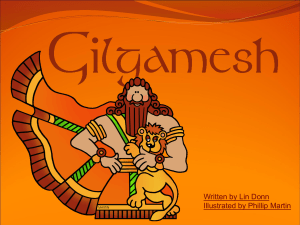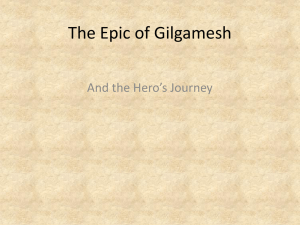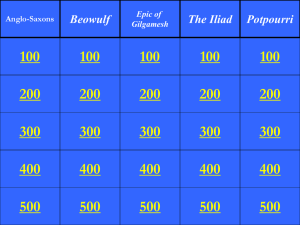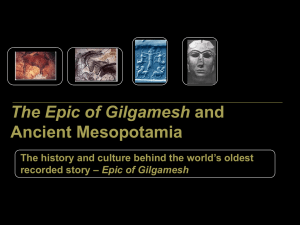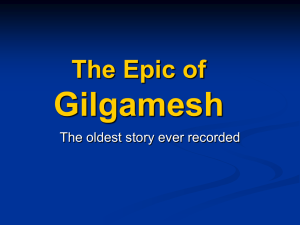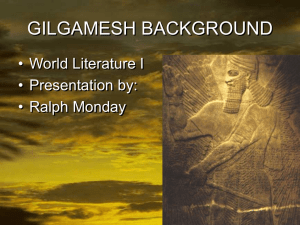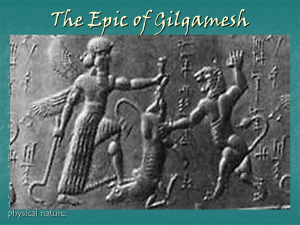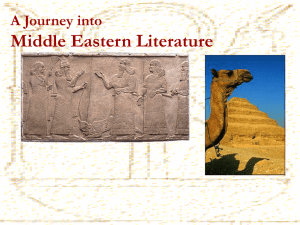The Epic of Gilgamesh - Robert B. Fitzpatrick, PLLC
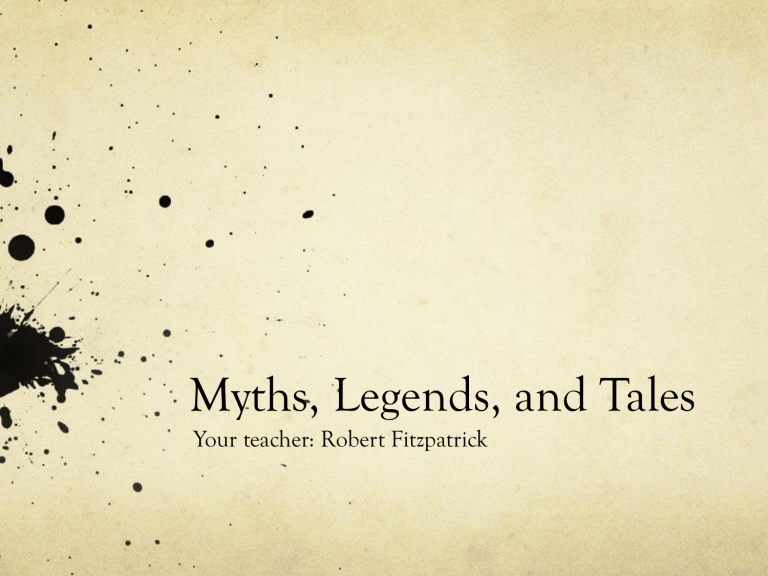
Myths, Legends, and Tales
Your teacher: Robert Fitzpatrick
Robert B Fitzpatrick, Teacher
Call your teacher: Bob
Email address: fitzpatrick.law@verizon.net
Class starts at 4:00 pm sharp
Room #305
Expected to be in your seats on time
Class
Class Rules
No talking among yourselves
If you want to speak, raise your hand, and wait to be called on
Everyone has a folder with your name on it- you are to bring this folder to every class- DO NOT LOSE IT
If you need to go to the bathroom- the sign is…..
This!
Rules Continued…..
Only one person at a time to go to the bathroom
No food is allowed, except for the school snack
No cell phones, ipods, or other electronics
Respect everyone
No shoving, pushing, fighting etc…
Remember, the most important thing is to have fun!
The Epic of Gilgamesh
Mesopotamia
Mesopotamia
Sumer
The Southernmost part of
Mesopotamia
Sumerian civilization dominated
Mesopotamia from around 5000
B.C.
It produced the oldest- known script
It also produced the world’s first cities by 3000 B.C.
Around 2334 B.C, King Sargon of Akkad in Northern
Mesopotamia united both the north and the south.
Fertile Crescent
The Fertile Crescent has been described as “the cradle of western civilization.”
Great civilizations arose in the Fertile Crescent, including the Sumerians,
The two rivers that fertilize the crescent are the Tigris and Euphrates.
When Gilgamesh Lived
Now, when Gilgamesh lived, it was thousands of years before the rise of the
Greeks, the Roman empire, Alexander The
Great and the Persian
Empire.
Name of Event
Persepolis is built
Greeks defeat Darius at Marathon
Persians defeated in a sea battle at Salamis
Date of Event
5 th -6 th centuries B.C. (B.C.E.)
490 B.C.
480 B.C.
Xerxes assassinated
Alexander the Great age 20, becomes king of
Macedonia
465 B.C.
336 B.C.
Alexander The Great age 32, died in
Babylon
323 B.C.
Constantinople declared to be 2 nd capital of
Roman Empire
330 A.D. (C.E.)
Rome falls to the Visigoths 410 A.D.
Persepolis
Persepolis was the capital of the Achaemenid Empire.
Greeks Defeat Darius at Marathon
The Battle of Marathon took place in 490 B.C. during the first Persian Invasion of Greece.
Persians Defeated in a Sea
Battle at Salamis
The Battle of Salamis was fought between an Alliance of Greek city-states and the Persian Empire in 480 B.C.
Xerxes is Assassinated
In 465 B.C. Xerxes of Persia was assassinated by
Artabanus, the commander of the royal bodyguard.
Alexander the Great
Alexander III of
Macedon, also known as
Alexander the Great, was King of the Greek state of Macedon.
Alexander The Great created one of the largest empires in ancient history, stretching from the Ionian Sea to the
Himalayas.
Constantinople
Constantinople was the capital of the Byzantine and
Ottoman Empires.
Throughout most of the Middle
Ages,
Constantinople was Europe’s largest and wealthiest city.
Rome Falls to the Visigoths
In 410 A.D. Rome was conquered for the first time in almost 800 years.
So, Where Did Gilgamesh Live?
In Mesopotamia.
What is that?
Mesopotamia is a Greek word meaning ‘between the rivers’ It is that area between the Tigris and
Euphrates Rivers.
Notice that these rivers are in what is now called the Middle East, and flow through Iraq, emptying into the Persian Gulf.
Discovery of the Epic
Before there were wordprocessors, typewriters, printing presses, papyrus – even before there was an alphabet, the Ancients in
Mesopotamia wrote on clay tablets made out of mud baked in the sun called
Cuneiforms on which they carved pictographs. They had no alphabet. So, they used symbols. To the right, here are some examples.
Archaeology
Archaeologists have discovered cuneiform tablets all over
Mesopotamia.
A cuneiform tablet can be seen at the University of
Pennsylvania
The Archeological Dig at Nineveh
In 1857, an archeologist named Austen Henry Layard had a dig going at Nineveh which is across the Tigris
River from the present-day city of Mosul in Iraq.
Nineveh was watered by two tributaries of the Tigris, the
Great and Little Zab Rivers.
It was the seat of power of the Assyrian Empire which ruled over a huge area from
North Africa to Persia between the 9 th and 7 th centuries B.C.E.
Assyrian Empire
The Greatest Assyrian king was Sargon who ruled from
722 B.C. to 705 B.C. For our purposes, The Greatest
Assyrian king was
Assurbanipal who became king in 669 B.C. This king acquired a huge library of more than 25,000 cuneiforms, which were discovered by the British archeologist Austen Henry
Layard.
George Smith
Most of the cuneiform discovered by Layard were transported to London where they remain to this very day in the British
Museum. Now, initially no one knew how to read them, and many tried without success. Then, George
Smith, a low-level employee of the museum who had no formal training, deciphered how to read the cuneiforms.
The Twelve Tablets
Once it was discovered how to read the cuneiforms, it was discovered that there were twelve tablets that told the epic of Gilgamesh.
The tablets were written around 1100 B.C./B.C.E. by the Babylonian scribe and scholar, Sin-lege-unninni, the
Homer of this story.
Here is the story that they tell:
The Story of a Great King:
Gilgamesh
Once upon a time, long, long ago there lived a great king named Gilgamesh
Now, Gilgamesh was no ordinary king. He was 2/3 immortal god and 1/3 ordinary mortal human.
This is his story.
He was the son of a semidivine father, Lugalbanda, and the goddess, Ninsun. As we said, he lived a long, long time ago – estimated around 2650 B.C.E. Now, how long ago is that? And, what does B.C.E. mean?
Gilgamesh Was King of Erech
It is said that he reigned for 120 years.
He was of super-human size and strength.
Erech ( Uruk)
Gilgamesh and Hercules
Some have speculated that the Greek myth of
Heracles (Hercules) was derived from the Epic of
Gilgamesh.
B.C.E. and B.E. – What Do
They Stand For?
B.C.E stands for Before the
Common Era, and C.E. stands for the Common Era.
This method is not the exclusive calendaring method.
B.C. stands for “Before
Christ.” A.D. stands for Anno
Domini, and refers to time after the birth of Christ.
Part of the world, countries like Saudi Arabia and Iran, use an entirely different calendar called the Hijri.
Above: an Assyrian Calendar
Allons Enfants de la Patrie…
After the French
Revolution, France, for a time, used the Revolution
Calendar. (See slide)
French Revolutionary Calendar
Name of the Month
Vendémiare
Brumaire
Frimaire
Nivôse
Pluviôse
Ventôse
Germinal
Floréal
Prairial
Messidor
Thermidor
Fructidor
Sans-Culottides
Derivation
Latin, vindemia - vintage
Brume - mist frimas - frost
Latin, nivosus - snow
Latin, rainy
Latin, ventosus - windy
Latin, germen - bud
Latin, florens - flowery
Pré - meadow
Latin, messis - harvest
Greek, therme - heat
Latin, fructus - fruit
Dates on our calendar
Sept 22 - Oct 21
Oct 22 – Nov 20
Nov 21- Dec 20
Dec 21 – Jan 19
Jan 20 – Feb 18
Feb 19 – Mar 20
Mar 21 – Apr 19
Apr 20 – May 19
May 20 – June 18
June 19 – July 18
July 19 – Aug 17
Aug 18 – Sept 16
Sept 17 – Sept 21
B.C.E. Continued
Now we count B.C.E. from the highest number descending to 1, being the year in which Jesus Christ allegedly was believed to be born. The year zero does not exist.
And, from one we count time in ascending dates and it is called A.D.
So, the year after 2650 B.C.E. is 2649 B.C.E, and so on until you get to one. Once you get to one B.C.E., the next year is 1 C.E. and so on.
B.C.E. Trivia Question
So, 2650 B.C.E. would be a total of how many years ago?
2650 B.C.E./B.C.
1
2011 C.E./A.D.
Dreads
The Kings of
Mesopotamia had square beards woven into dreadlocks.
Sumerian King - Lists
On cuneiforms, there was found the Sumerian King –
Lists, and Gilgamesh is listed as the fifth king of the first dynasty of Uruk (Erech in
Greek; Warka in Arabic).
He was an arrogant king who abused the people
The people prayed to the gods to create another creature equal in strength to
Gilgamesh.
Creation of Enkidu
The goddess Aruru created from a lump of clay, Enkidu.
Enkidu, while human, lived like a wild beast and possessed immense strength, just like
Gilgamesh.
The Taming of Enkidu
Gilgamesh sends a woman to tame Enkidu, and she does.
She convinces Enkidu to clean himself up and come live in Uruk.
He agrees to come.
The Wrestling Match
When Gilgamesh and
Enkidu meet, they have a wrestling match as a trial of strength.
Neither man can win, neither can best the other it is….. a draw. And, they become great friends.
Friendship
Realizing that they are equals, King Gilgamesh and Enkidu become great friends and boon companions.
And, King Gilgamesh stops abusing the people of Uruk.
The Cedar Forests
Mesopotamia has virtually no trees and therefore to find wood, one had to travel to the forests closer to the Mediterranean.
In the Amanus mountain range, there are cedar forests. Mt. Saphon is there, some 20 miles north of Ras
Shamra.
The forests are guarded by a monster, Humbaba, sometimes called Huwawa.
Humbaba
Gilgamesh and Enkidu attack and slay the firebreathing giant, Humbaba.
Humbaba, sometimes called
Huwawa, guarded the cedar forests.
They cut off Humbaba’s head.
The cedar forests were the home of Ishtar, the Queen of Heaven.
Ishtar’s Revenge
Ishtar falls in love with
Gilgamesh, but he rejects her.
Ishtar then begs Anu, the sky god for revenge.
Anu creates a bull that ravages the kingdom, and eventually Enkidu and
Gilgamesh kill the bull.
The Bull of Heaven
Anu creates the Bull of
Heaven which descends upon Uruk.
There is a famine for seven years.
Eventually, Enkidu and
Gilgamesh kill the Bull.
They cut out its heart and offer it to the sun god
Shamash.
The Death of Enkidu
The gods then decide that Enkidu must die, and he does die from a fever that lasts twelve days.
Why Twelve Days?
Scholars believe that twelve days was used because it is the basis of
Mesopotamian mathematics, which is called the sexagesimal system.
The Search for Immortality
When Enkidu dies,
Gilgamesh begins to fear that he too will die, and he brings to search for immortality.
Only one human has been made immortal, Utnapishtim.
The Mountain of Mashu and the Scorpion-Man
Gilgamesh goes on a journey to find Ut-napishtim, and gets to the foot of the mountains called Mashu, which is guarded by a scorpion-man and his wife.
Gilgamesh Arrives at the Waters of Death
The water of death are guarded by the goddess
Siduri.
Siduri tries to convince
Gilgamesh from attempting to cross the waters of death, and thusly to enjoy life.
He gets across the waters with the help of
Urshanabi.
The Story of the Flood
When Gilgamesh crosses the river, he comes to the home of Ut-napishtim, and he tells him the story of the flood. Ut-napishtim is known as the “Babylonian
Noah.”
The Quest for Immortality
Ut-napishtim tells
Gilgamesh that the gods have reserved immortality for themselves and death is the lot of mankind.
The Magic Plant
But he then tells him of a plant at the bottom of the sea that provides immortality.
Gilgamesh swims to the bottom and gets the plant and heads back to Uruk.
On his way back, he stops to bathe in a stream.
While he is bathing, a snake swallows the plant, and sloughes off it’s old skin.
Good King Gilgamesh
Once Gilgamesh realized that he could not achieve eternal life, he decided to achieve immortality by leading a good life and being a good king.
For the remainder of his life, he devoted himself to his people and to the city of Uruk.
The Walls of Uruk
One of the cuneiforms describes the walls of
Uruk that King
Gilgamesh built as being
“the like of which no king, no man, will ever build.”
He decorated the walls with lapus luzili.
Lapus Luzili
This precious stone, which is intensely blue, decorates many of the temples found by archeologists in
Mesopotamia.
This precious stone was mined in the mountains of Northern Afghanistan, near Badakhshan, thousands of miles away.
Lazurite
Lazurite is a mineral found in lapus luzili.
Lazurite was used to make paint by well-known artists of the Renaissance.
The Death of Gilgamesh
When Gilgamesh dies, the people divert the waters of the river and bury him under the water.


